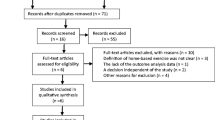Abstract
Balance impairment is a frequent and undertreated manifestation in ankylosing spondylitis, leading to increased risk of falls and lower quality of life. Our aim was to assess supervised training and home-based rehabilitation efficacy on balance improvement in ankylosing spondylitis subjects on biologic agents. This was a single-blinded, quasi-randomized parallel study in a single outpatient Rehabilitation Clinic of a tertiary referral center. Subjects with ankylosing spondylitis on biologic agents were assigned either to supervised training and home-based rehabilitation program (rehabilitation group) plus educational–behavioral therapy, or to educational–behavioral therapy alone (educational groups). The same therapist provided therapy. Outcome measures were assessed at baseline (T0), end of treatment (T1) and at 7-month follow-up (T2). Rheumatologic outcomes were Bath Ankylosing Spondylitis Metrology Index, Bath Ankylosing Spondylitis Functional Index and Bath Ankylosing Spondylitis Disease Activity Index. Balance parameters (anterior–posterior oscillation, latero-lateral oscillation, sway area, sway density and sway path) were evaluated by stabilometry in a condition of open and closed eyes. Forty-six subjects (36 M, 10 F) were enrolled. Demographic data and clinical status at baseline were comparable between the two groups (22 rehabilitation group, 20 educational group). Primary outcome was sway density that improved both at T1 (SDy: open eyes p = 0.003, closed eyes p = 0.004) and at T2 (SDx: open eyes p = 0.0015, closed eyes p = 0.032). A trend toward improvement in the rehabilitation group rather than in the educational group emerged for balance parameters, especially those measured with closed eyes (0.004 < p < 0.048 at T1 and 0.004 < p < 0.036 at T2). Supervised training and home exercise lead to balance improvement in people with ankylosing spondylitis. Eyes-closed trials show a more marked trend toward improvement, and this may suggest a positive effect of rehabilitation on proprioception.

Similar content being viewed by others
References
Adam M, Erkan AN, Arslan D, Leblebici B, Ozluoglu L, Nafiz Akman M (2008) High-frequency sensorineural hearing loss in patients with ankylosing spondylitis: Is it an extraarticular feature of disease? Rheumatol Int 28:413–417
Amor-Dorado JC, Barreira-Fernandez MP, Vazquez-Rodriguez TR, Gomez-Acebo I, Miranda-Filloy JA, Diaz de Teran T et al (2011) Audiovestibular manifestations in patients with ankylosing spondylitis. Medicine (Baltimore) 90:99–109
Erbek SS, Erbek HS, Yilmaz S, Topal O, Yucel E, Ozluoglu LN (2006) Cochleovestibular dysfunction in ankylosing spondylitis. Audiol Neurootol 11:294–300
Murray HC, Elliott C, Barton SE, Murray A (2000) Do patients with ankylosing spondylitis have poorer balance than normal subjects? Rheumatology (Oxford) 39:497–500
Pompeu JE, Romano RS, Pompeu SM, Lima SM (2012) Static and dynamic balance in subjects with ankylosing spondylitis: literature review. Rev Bras Reumatol 52:409–416
Sawacha Z, Carraro E, Del Din S, Guiotto A, Bonaldo L, Punzi L, et al (2012) Biomechanical assessment of balance and posture in subjects with ankylosing spondylitis. J Neuroeng Rehabil 29:63-0003-9-63
Vergara ME, O’Shea FD, Inman RD, Gage WH (2012) Postural control is altered in patients with ankylosing spondylitis. Clin Biomech (Bristol, Avon) 27:334–340
Dagfinrud H, Kvien TK, Hagen KB (2004) Physiotherapy interventions for ankylosing spondylitis. Cochrane Database Syst Rev. 18(4): CD002822. Review. Update in: Cochrane Database Syst Rev. 2008; (1):CD002822
Masiero S, Bonaldo L, Pigatto M, Lo Nigro A, Ramonda R, Punzi L (2011) Rehabilitation treatment in patients with ankylosing spondylitis stabilized with tumor necrosis factor inhibitor therapy: a randomized controlled trial. J Rheumatol 38:1335–1342
Giannotti E, Trainito S, Arioli G, Rucco V, Masiero S (2014) Effects of physical therapy for the management of patients with ankylosing spondylitis in the biological era. Clin Rheumatol 33:1217–1230
Masiero S, Poli P, Bonaldo L, Pigatto M, Ramonda R, Lubrano E et al (2013) Supervised training and home-based rehabilitation in patients with stabilized ankylosing spondylitis on TNF inhibitor treatment: a controlled clinical trial with a 12-month follow-up. Clin Rehabil 28:562–572
Boutron I, Moher D, Altman DG, Schulz KF, Ravaud P, CONSORT Group (2008) Extending the CONSORT statement to randomized trials of non-pharmacologic treatment: explanation and elaboration. Ann Intern Med 148:295–309
Braun J, van den Berg R, Baraliakos X, Boehm H, Burgos-Vargas R, Collantes-Estevez E et al (2011) 2010 Update of the ASAS/EULAR recommendations for the management of ankylosing spondylitis. Ann Rheum Dis 70:896–904
Horak FB, Macpherson JM (1996) Postural orientation and equilibrium. In: Rowell LB, Shepherd JT (eds) Handbook of physiology, section 12, exercise: regulation and integration of multiple systems. American Physiological Society, New York, pp 255–292
Aydog E, Depedibi R, Bal A, Eksioglu E, Unlu E, Cakci A (2006) Dynamic postural balance in ankylosing spondylitis patients. Rheumatology (Oxford) 45:445–448
van der Heijde D, Braun J, Deodhar A, Inman RD, Xu S, Mack ME, Hsu B (2013) Comparison of three enthesitis indices in a multicentre, randomized, placebo-controlled trial of golimumab in ankylosing spondylitis (GO-RAISE). Rheumatology (Oxford) 52:321–325
Author information
Authors and Affiliations
Corresponding author
Ethics declarations
Conflict of Interest
The authors declare that they have no conflict of interest to declare in relation to this work.
Appendix
Rights and permissions
About this article
Cite this article
Demontis, A., Trainito, S., Del Felice, A. et al. Favorable effect of rehabilitation on balance in ankylosing spondylitis: a quasi-randomized controlled clinical trial. Rheumatol Int 36, 333–339 (2016). https://doi.org/10.1007/s00296-015-3399-6
Received:
Accepted:
Published:
Issue Date:
DOI: https://doi.org/10.1007/s00296-015-3399-6




